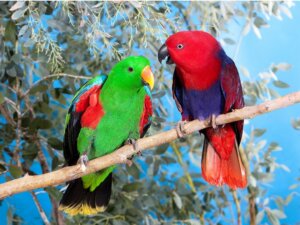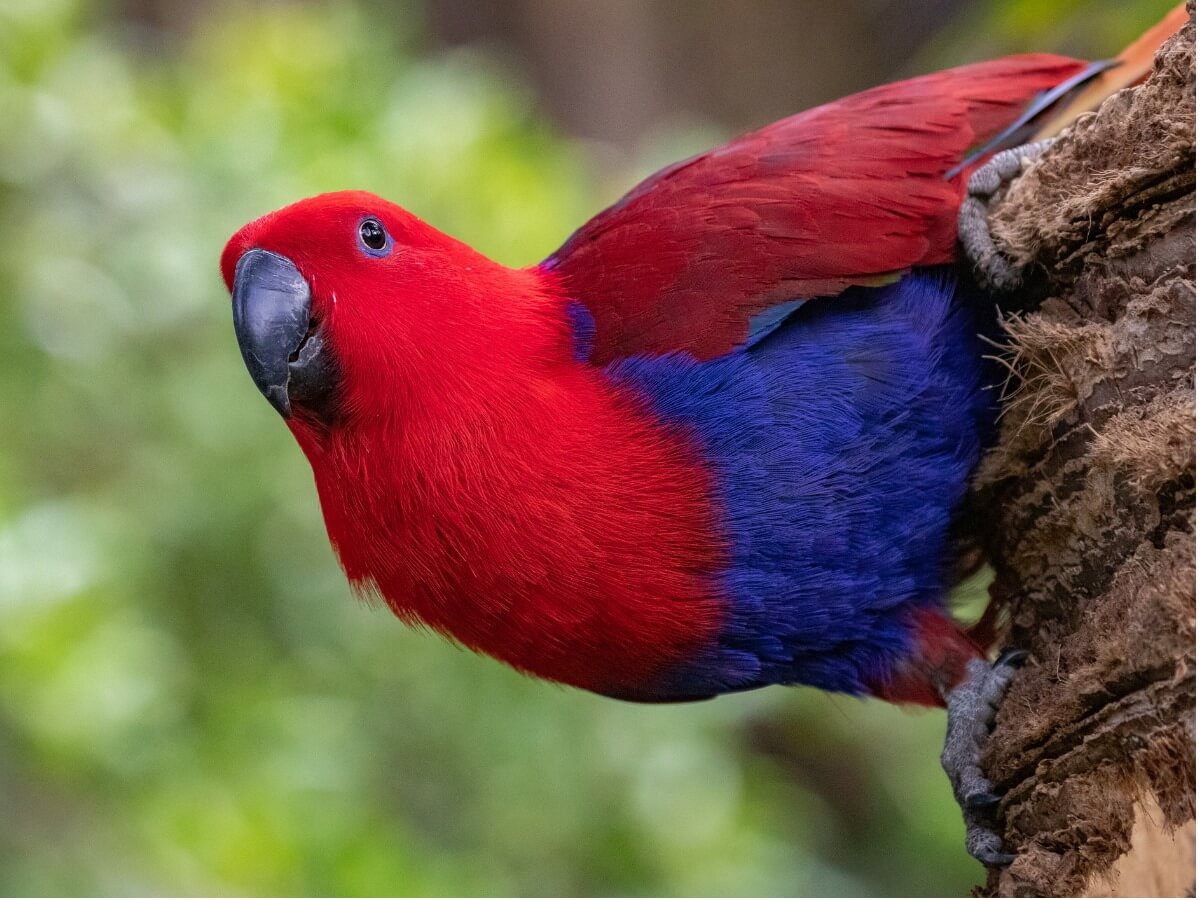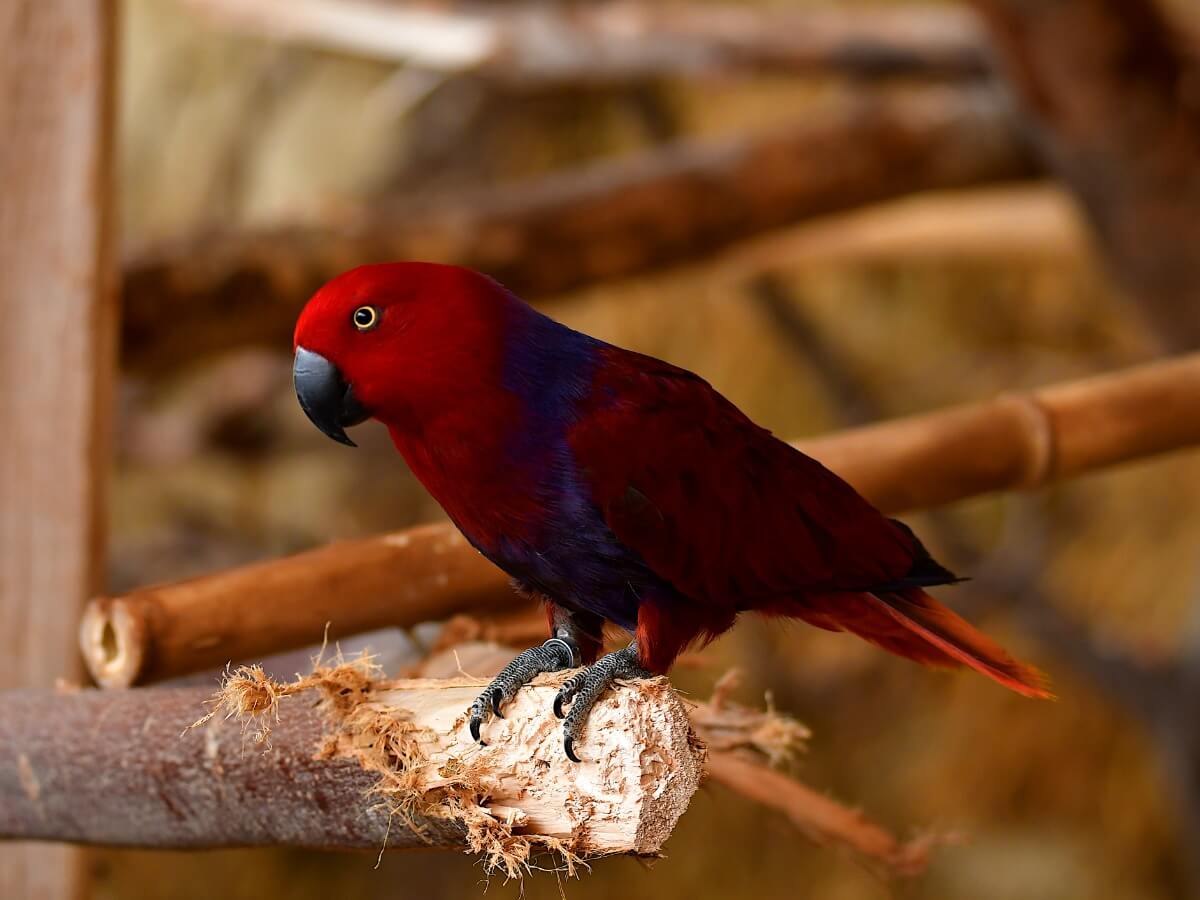Eclectus Parrot: Habitat and Characteristics


Reviewed and approved by the biologist Samuel Sanchez
The eclectus parrot (Eclectus roratus) is a small bird that attracts attention thanks to its colorful plumage and high-pitched vocalization. Its delicate feathers give the visual impression of being hairs rather than avian attributes, which is one of the reasons this bird is considered an exotic pet.
The 10 subspecies within this species don’t usually vary much from one to the other, as sexual dimorphism is present in all of them and is their most striking characteristic. In addition, it should be noted that the plumage is maintained thanks to the nutrients that the eclectus parrot absorbs through its diet. Next up, you’ll find the most important and curious aspects about this little bird.
Eclectus parrot habitat
The eclectus parrot covers a fairly wide distribution in terms of habitats. The ecosystems most likely to be home to this bird are mangroves, savannas and forests located in New Guinea, the Solomon Islands, northeastern Australia and the Moluccas Islands.
In the same way, this species usually lives between coconut plantations and eucalyptus forests, at a height of no more than 1900 meters (just over a mile). Consequently, we can say that this bird is common in coastal areas, lowland forests, and some areas dedicated to the aforementioned crops.

Physical characteristics
The eclectus parrot has a size that ranges from 35 to 42 centimeters and a weight of between 355 and 615 grams. On the other hand, it’s an easy bird to distinguish, thanks to the strong sexual dimorphism that males and females have. The plumage of the males has colors like coral and green feathers, although they have some red and blue on their wings, as well as an orange beak.
For their part, females have a black beak and red plumage, which is usually darker on the back. Blue and purple also predominates in females, especially on the chest and throat. Their tail is orange-yellow above and below it’s a dark red, which lightens towards a yellow-pink color at the end.
Among other aspects to highlight, the eclectus parrot is a fairly long-lived animal that manages to reach up to 80 years of life. This bird is usually quite calm and doesn’t bother when kept in captivity as a pet. However, if it shares space with one of the same species, it’s normal for both of them to create a lot of fuss just to mark their territory or communicate.
Eclectus parrot behavior
Regarding the behavior of the eclectus parrot, it has been observed that they’re very curious and intelligent birds. They’re distinguished from others thanks to their high vocalization, with which they can sometimes annoy their owners. However, it’s usually a friendly animal in captivity if the owners earn its trust.
The character of the eclectus parrot depends on the gender. While the female is more dominant, the male is usually a bit independent and distant.
In the wild, these birds are characterized by being somewhat solitary, although they can also be seen in pairs or in small groups, in which males predominate (especially during reproduction). When the eclectus parrot groups together, it usually does so in the treetops, although specimens can also be seen flying over at dawn or dusk, when they’re most active.
Feeding the eclectus parrot
The eclectic parrot’s diet is mostly fruit-based, although some may prefer vegetables. The Eclectus roratus species enjoys ripe fruit, but not rotten. Interestingly, the digestive system of this animal is longer than that of other parrots, so it needs a diet high in plant protein and beta-carotene.
When you have an eclectus parrot as a pet, it’s important to guarantee the optimal vitamins for its development, especially A, E, and D. The bird’s diet should be as healthy as possible, as the increases in body fat would cause black feathers. because of stress. Consequently, granulated feeds aren’t recommended, as they contain a lot of sugar and tend to cause kidney problems.
Also, it’s important that processed foods are avoided, as the eclectic parrot is susceptible to the toxins that some products have. In general, the best diet for this bird is fresh fruits and some vegetables that are to its liking.
Reproduction of the eclectus parrot
The reproduction of this bird depends on its geographical location, because if it’s found in Australia, its copulation will be between July and February. On the other hand, if they live in the Solomon Islands, they’ll copulate between June and September. When it lives in Papua New Guinea, it can breed at any time.
Usually, these birds nest in holes in the trunks of large trees. On some occasions, the same tree can have more than one nest, with several birds even taking care of the same clutch. Incubation covers a period of 25 to 30 days, in which the female lays 2 eggs, which are generally oval and shiny. The rearing of the chicks usually lasts 3 months.
The females are responsible for incubation and leave the young alone when feeding. In the same way, the chicks are fed by the male when the first eggs hatch, although little by little the female takes on the task in its entirety.
State of conservation
According to the International Union for Conservation of Nature (IUCN), the eclectus parrot is not in greater danger of extinction, as its conservation status is “Least Concern (LC)”. However, the species sometimes faces illegal trafficking of species as a result of its beauty and plumage, so its population has decreased a bit in recent years.
The eclectus parrot as a pet
Taking into account the bird’s characteristics, behavior and nutritional needs, it’s important to guarantee adequate space and a balanced diet. The eclectus parrot needs a large cage or aviary at least 4 meters high by 2 meters wide, where it can spread its wings well. The installation can have wooden wires and hangers.
The eclectus parrot should also leave the cage for short walks, provided that the owner has built sufficient trust with the bird. In this way, the bird will be more calm and comfortable with its surroundings.
Regarding the climatic conditions, this bird adapts to changes in temperature, although it does not bear the cold well, which is why it should be offered a good shelter. As for food, you can provide vegetables such as carrots, corn, lettuce or tomato. Fruits like apples and pears are ideal for their diet, which must be strong in vitamin A for their plumage to shine brighter.

As you can appreciate, the eclectus parrot is a bird that doesn’t cause major problems when kept as a pet, although in its natural habitat it’s usually more territorial and noisy in order to be able to communicate with its parents. Its diet is the source of its beauty, so it’s essential to eliminate from its diet any element that affects its health and physical appearance.
The eclectus parrot (Eclectus roratus) is a small bird that attracts attention thanks to its colorful plumage and high-pitched vocalization. Its delicate feathers give the visual impression of being hairs rather than avian attributes, which is one of the reasons this bird is considered an exotic pet.
The 10 subspecies within this species don’t usually vary much from one to the other, as sexual dimorphism is present in all of them and is their most striking characteristic. In addition, it should be noted that the plumage is maintained thanks to the nutrients that the eclectus parrot absorbs through its diet. Next up, you’ll find the most important and curious aspects about this little bird.
Eclectus parrot habitat
The eclectus parrot covers a fairly wide distribution in terms of habitats. The ecosystems most likely to be home to this bird are mangroves, savannas and forests located in New Guinea, the Solomon Islands, northeastern Australia and the Moluccas Islands.
In the same way, this species usually lives between coconut plantations and eucalyptus forests, at a height of no more than 1900 meters (just over a mile). Consequently, we can say that this bird is common in coastal areas, lowland forests, and some areas dedicated to the aforementioned crops.

Physical characteristics
The eclectus parrot has a size that ranges from 35 to 42 centimeters and a weight of between 355 and 615 grams. On the other hand, it’s an easy bird to distinguish, thanks to the strong sexual dimorphism that males and females have. The plumage of the males has colors like coral and green feathers, although they have some red and blue on their wings, as well as an orange beak.
For their part, females have a black beak and red plumage, which is usually darker on the back. Blue and purple also predominates in females, especially on the chest and throat. Their tail is orange-yellow above and below it’s a dark red, which lightens towards a yellow-pink color at the end.
Among other aspects to highlight, the eclectus parrot is a fairly long-lived animal that manages to reach up to 80 years of life. This bird is usually quite calm and doesn’t bother when kept in captivity as a pet. However, if it shares space with one of the same species, it’s normal for both of them to create a lot of fuss just to mark their territory or communicate.
Eclectus parrot behavior
Regarding the behavior of the eclectus parrot, it has been observed that they’re very curious and intelligent birds. They’re distinguished from others thanks to their high vocalization, with which they can sometimes annoy their owners. However, it’s usually a friendly animal in captivity if the owners earn its trust.
The character of the eclectus parrot depends on the gender. While the female is more dominant, the male is usually a bit independent and distant.
In the wild, these birds are characterized by being somewhat solitary, although they can also be seen in pairs or in small groups, in which males predominate (especially during reproduction). When the eclectus parrot groups together, it usually does so in the treetops, although specimens can also be seen flying over at dawn or dusk, when they’re most active.
Feeding the eclectus parrot
The eclectic parrot’s diet is mostly fruit-based, although some may prefer vegetables. The Eclectus roratus species enjoys ripe fruit, but not rotten. Interestingly, the digestive system of this animal is longer than that of other parrots, so it needs a diet high in plant protein and beta-carotene.
When you have an eclectus parrot as a pet, it’s important to guarantee the optimal vitamins for its development, especially A, E, and D. The bird’s diet should be as healthy as possible, as the increases in body fat would cause black feathers. because of stress. Consequently, granulated feeds aren’t recommended, as they contain a lot of sugar and tend to cause kidney problems.
Also, it’s important that processed foods are avoided, as the eclectic parrot is susceptible to the toxins that some products have. In general, the best diet for this bird is fresh fruits and some vegetables that are to its liking.
Reproduction of the eclectus parrot
The reproduction of this bird depends on its geographical location, because if it’s found in Australia, its copulation will be between July and February. On the other hand, if they live in the Solomon Islands, they’ll copulate between June and September. When it lives in Papua New Guinea, it can breed at any time.
Usually, these birds nest in holes in the trunks of large trees. On some occasions, the same tree can have more than one nest, with several birds even taking care of the same clutch. Incubation covers a period of 25 to 30 days, in which the female lays 2 eggs, which are generally oval and shiny. The rearing of the chicks usually lasts 3 months.
The females are responsible for incubation and leave the young alone when feeding. In the same way, the chicks are fed by the male when the first eggs hatch, although little by little the female takes on the task in its entirety.
State of conservation
According to the International Union for Conservation of Nature (IUCN), the eclectus parrot is not in greater danger of extinction, as its conservation status is “Least Concern (LC)”. However, the species sometimes faces illegal trafficking of species as a result of its beauty and plumage, so its population has decreased a bit in recent years.
The eclectus parrot as a pet
Taking into account the bird’s characteristics, behavior and nutritional needs, it’s important to guarantee adequate space and a balanced diet. The eclectus parrot needs a large cage or aviary at least 4 meters high by 2 meters wide, where it can spread its wings well. The installation can have wooden wires and hangers.
The eclectus parrot should also leave the cage for short walks, provided that the owner has built sufficient trust with the bird. In this way, the bird will be more calm and comfortable with its surroundings.
Regarding the climatic conditions, this bird adapts to changes in temperature, although it does not bear the cold well, which is why it should be offered a good shelter. As for food, you can provide vegetables such as carrots, corn, lettuce or tomato. Fruits like apples and pears are ideal for their diet, which must be strong in vitamin A for their plumage to shine brighter.

As you can appreciate, the eclectus parrot is a bird that doesn’t cause major problems when kept as a pet, although in its natural habitat it’s usually more territorial and noisy in order to be able to communicate with its parents. Its diet is the source of its beauty, so it’s essential to eliminate from its diet any element that affects its health and physical appearance.
All cited sources were thoroughly reviewed by our team to ensure their quality, reliability, currency, and validity. The bibliography of this article was considered reliable and of academic or scientific accuracy.
- Heinsohn, R. (2008). Ecology and evolution of the enigmatic eclectus parrot (Eclectus roratus). Journal of Avian Medicine and Surgery, 22(2), 146-150.
- Heinsohn, R., & Legge, S. (2003). Breeding biology of the reverse-dichromatic, co-operative parrot Eclectus roratus. Journal of Zoology, 259(2), 197-208.
- Vapniarsky, N., Barr, B. C., & Murphy, B. (2012). Systemic Coxiella-like infection with myocarditis and hepatitis in an eclectus parrot (Eclectus roratus). Veterinary pathology, 49(4), 717-722.
- Johnston, M. S., Son, T. T., & Rosenthal, K. L. (2007). Immune-mediated hemolytic anemia in an eclectus parrot. Journal of the American Veterinary Medical Association, 230(7), 1028-1031.
- Cowan, M. L., Yang, P. J., Monks, D. J., & Raidal, S. R. (2011). Suspected osteoma in an eclectus parrot (Eclectus roratus roratus). Journal of avian medicine and surgery, 25(4), 281-285.
This text is provided for informational purposes only and does not replace consultation with a professional. If in doubt, consult your specialist.








